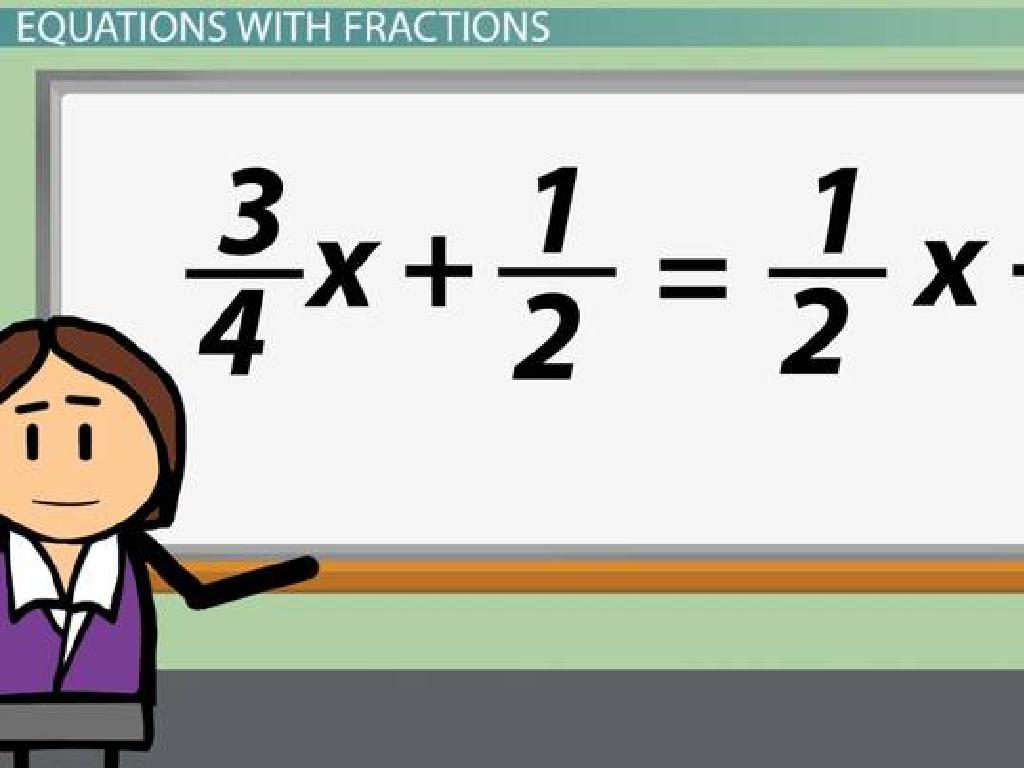Evaluate Numerical Expressions
Subject: Math
Grade: Fifth grade
Topic: Numerical Expressions
Please LOG IN to download the presentation. Access is available to registered users only.
View More Content
Evaluating Numerical Expressions
– Exploring math expressions
– Math as a language
– Math uses symbols to represent ideas, like words in a language.
– Defining numerical expressions
– A combination of numbers and operations without an equal sign.
– Practice with examples
– Use given values to find the expression’s value.
|
This slide introduces the concept of evaluating numerical expressions, which is a fundamental skill in mathematics. Begin by explaining that math is like a language with its own rules and symbols, which we use to communicate ideas. Numerical expressions are parts of this language, consisting of numbers and operations like addition, subtraction, multiplication, and division. They do not include an equal sign, which differentiates them from equations. Provide examples of numerical expressions and demonstrate how to evaluate them by substituting numbers for any variables and performing the indicated operations step by step. Encourage students to see the patterns and logic behind the operations as they work through examples.
Understanding Numerical Expressions
– Numerical expressions basics
– A mix of numbers and math operations
– Examples of numerical expressions
– For instance: 3 + 4, 6 x 5, (8 – 2) / 3
– Difference from equations
– They don’t have an equal sign, unlike equations
– Evaluating expressions
– Practice calculating the value of expressions
|
This slide introduces the concept of numerical expressions to fifth-grade students. Begin by explaining that a numerical expression is a mathematical phrase involving numbers and operation signs like plus, minus, times, and divided by. Show examples on the board and work through them together. Clarify that unlike equations, numerical expressions do not have an equal sign and are not solved for a variable. Instead, we evaluate them by performing the operations in the correct order. Encourage students to practice with various examples to become comfortable with the concept. Provide guidance on the order of operations and ensure they understand the importance of following these rules when evaluating expressions.
Understanding Order of Operations
– Rules for evaluating expressions
– Follow specific steps to solve math problems correctly.
– Learn PEMDAS
– Parentheses, Exponents, Multiplication/Division, Addition/Subtraction.
– Breaking down each step
– We’ll explore how to apply each part of PEMDAS with examples.
|
This slide introduces the concept of Order of Operations, which is crucial for correctly evaluating numerical expressions. PEMDAS is an acronym that helps students remember the order in which to perform operations: Parentheses, Exponents, Multiplication and Division (from left to right), and Addition and Subtraction (from left to right). Emphasize that operations within parentheses come first, followed by any exponents. Multiplication and division are next and are treated equally; they are done from left to right. The same goes for addition and subtraction. Provide examples for each step, such as (3 + 2) × 5^2 and 48 ÷ 6 + 3, and solve them as a class to demonstrate the process. Encourage students to practice with simple expressions before moving on to more complex ones.
Understanding Parentheses in Numerical Expressions
– Solve inside parentheses first
– Example: (3 + 4) x 2
– First, add 3 + 4 to get 7, then multiply by 2 to get 14
– Parentheses affect the result
– Without parentheses: 3 + (4 x 2) equals 11, not 14
– Practice with different expressions
– Try (5 + 6) x 3 or (2 + 9) / 4 and see how parentheses change answers
|
This slide introduces the concept of using parentheses in numerical expressions and their importance in determining the outcome of mathematical operations. Emphasize that operations within parentheses should be completed first, according to the order of operations (PEMDAS/BODMAS). Provide the example (3 + 4) x 2 to illustrate how to approach these expressions step by step. Highlight how the placement of parentheses can alter the result of the expression, reinforcing the concept with additional practice problems. Encourage students to solve these problems and observe the differences in results with and without parentheses.
Understanding Exponents in Numerical Expressions
– Exponents show repeated multiplication
– Example: 2^3 is 2 multiplied by itself twice
– It’s like saying 2 times 2 times 2
– Solve parentheses before exponents
– Remember: PEMDAS (Parentheses, Exponents, Multiplication/Division, Addition/Subtraction)
– Practice with different base numbers
– Try examples like 3^2, 4^3, and 5^1 to understand patterns
|
This slide introduces students to the concept of exponents as a part of evaluating numerical expressions. Exponents are a shorthand way to express repeated multiplication of the same number. It’s crucial to explain that exponents come after solving any operations within parentheses due to the order of operations (PEMDAS). Provide students with examples to illustrate how exponents work and encourage them to calculate exponents with different base numbers to familiarize themselves with the concept. In the next class, students can practice more exponent problems and share their solutions.
Multiplication and Division in Numerical Expressions
– Perform operations left to right
– Example: 18 / 2 x 3
– First, divide 18 by 2 to get 9, then multiply 9 by 3 to get 27
– Multiplication & division are equal
– Remember, neither multiplication nor division comes first
– Solve step-by-step
– Always start with the leftmost operation and move right
|
This slide focuses on teaching students the correct order of operations for multiplication and division, which are of equal priority. It’s crucial to emphasize that they should perform these operations from left to right as they appear in the expression. Use the example 18 / 2 x 3 to illustrate this point. Walk through the problem step-by-step with the class, dividing 18 by 2 to get 9, and then multiplying 9 by 3 to arrive at the answer, 27. Reinforce the concept that multiplication and division should be treated with equal importance and solved in the order they appear, not by choosing to multiply before dividing or vice versa. Encourage students to practice with additional examples to solidify their understanding.
Evaluating Expressions: Addition & Subtraction
– Perform operations left to right
– Example: 7 + 3 – 2
– Start with 7 + 3 to get 10, then subtract 2 to end with 8
– Addition before subtraction
– If both present, add before you subtract
– Final step in expressions
– After dealing with parentheses and multiplication/division
|
This slide focuses on the correct order of operations for addition and subtraction in numerical expressions. Students should understand that they must work from left to right, as they read. Using the example 7 + 3 – 2, demonstrate how to add 7 and 3 first, then subtract 2 from the sum. Emphasize that if both addition and subtraction are in an expression, they should perform the addition first, followed by subtraction. This is typically the last step after parentheses and multiplication/division have been resolved. Encourage students to practice with additional examples and to check their work by reversing the operations.
Let’s Practice Together: Evaluating Expressions
– Evaluate: (5 + 3) x 2^2
– First, add 5 + 3 to get 8
– Step-by-step walkthrough
– Next, calculate 2^2 which is 4
– Check your answer
– Multiply 8 by 4 to get 32
– Discuss with a partner
– Compare results and methods used
|
This slide is an interactive class activity designed to help students practice evaluating numerical expressions. Start by solving the expression (5 + 3) x 2^2 together as a class. Explain the order of operations: parentheses first, then exponents, followed by multiplication. Walk through each step on the board, ensuring students understand why each step is necessary. After completing the walkthrough, have students check their work with a partner to reinforce the concept and encourage peer learning. Provide additional similar expressions for students to practice with their partners, and facilitate a discussion afterward to address any questions or different methods they might have encountered.
Your Turn to Evaluate!
– Evaluate: 4 x (2 + 6)
– First, add 2 + 6, then multiply the result by 4.
– Evaluate: (3^2 + 1) x 5
– Square 3 to get 9, add 1, then multiply by 5.
|
This slide is an activity for students to practice evaluating numerical expressions. Encourage them to follow the order of operations: parentheses, exponents, multiplication, and addition. For the first expression, they should add the numbers in the parentheses and then multiply by 4. For the second expression, they should square the number 3, add 1 to the result, and then multiply by 5. Remind them to work step by step and check their work as they go. Provide guidance as needed and be ready to assist any student who may struggle with the concept of order of operations.
Class Activity: Expression Creation
– Create your own numerical expressions
– Swap with a classmate to evaluate
– Exchange papers and solve your friend’s expressions
– Share your findings with the class
– Discuss the results and methods used in class
|
This interactive activity is designed to engage students with the concept of evaluating numerical expressions. Each student will create their own set of expressions using addition, subtraction, multiplication, or division. After creating their expressions, students will swap their work with a classmate and solve the given problems. This peer review process not only reinforces their understanding but also allows them to see different approaches to problem-solving. Once completed, students will share their original expressions and the solutions they found for their classmate’s expressions. For the teacher: Prepare to facilitate the activity by ensuring students understand the order of operations and provide guidance as needed. Have a few extra expressions ready for students who finish early, and consider pairing students strategically to ensure a productive exchange.
Wrapping Up: Evaluating Expressions
– Excellent work in today’s lesson
– Homework: Finish the expressions worksheet
– The worksheet has various problems to solve
– Practice is key to mastery
– The more you practice, the better you’ll understand
– Keep up the great effort!
|
Today’s class focused on evaluating numerical expressions, and the students did a great job. For homework, they are assigned a worksheet that contains a variety of expressions to evaluate. This practice will help reinforce the concepts learned in class and improve their skills. Remind students that consistent practice is essential for mastering mathematical concepts. Encourage them to approach the worksheet with the same enthusiasm as they did in class and to reach out if they encounter any difficulties. The next class will review the homework and address any questions, ensuring that all students are confident in evaluating numerical expressions.






